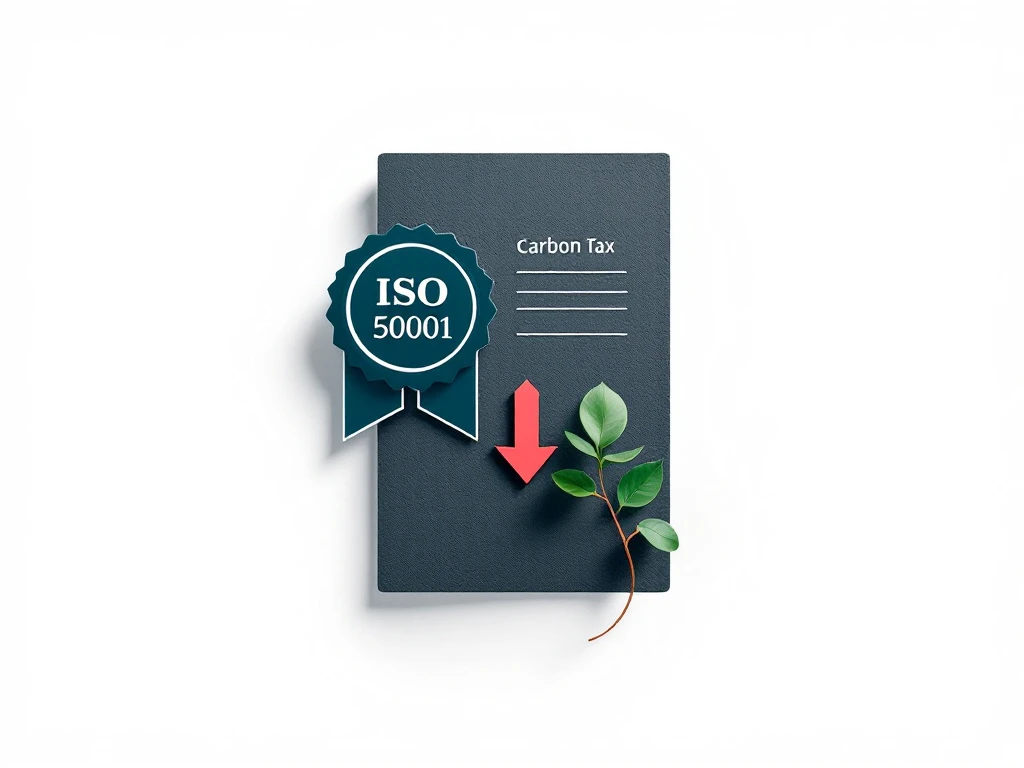
Andres Fellenberg Van der Molen
Director at Green Partner Europe | Hotels Specialist | Sustainability | Energy Efficiency | Circular Economy | Zero Waste | CSR | ESG | SDG

Can ISO 50001 certification reduce carbon tax obligations?
Implementing an internationally recognized energy management system like ISO 50001 offers organizations significant opportunities to lower their carbon-related tax liabilities. By systematically improving energy efficiency and reducing emissions, certified organizations can qualify for various financial incentives, including tax rebates, exemptions, and reduced carbon levies across different jurisdictions. The structured approach to energy management that this certification provides helps businesses demonstrate compliance with environmental regulations while potentially delivering substantial financial benefits through reduced tax obligations.
What is ISO 50001 certification and how does it relate to carbon taxation?
ISO 50001 is an internationally recognized standard that provides organizations with a framework to develop an effective energy management system (EnMS). This standard enables businesses to establish systems and processes necessary to improve energy performance, efficiency, and consumption. Unlike other management systems, ISO 50001 specifically targets energy usage reduction and optimization across all organizational operations.
Carbon taxation, meanwhile, represents a policy instrument implemented by governments to put a price on carbon emissions. These taxes are designed to internalize the environmental costs of greenhouse gas emissions and incentivize businesses to reduce their carbon footprint. The relationship between energy management systems and carbon tax frameworks is direct and significant – the more efficiently an organization manages its energy use, the fewer emissions it produces, potentially resulting in lower carbon tax liability.
Many jurisdictions worldwide have recognized this connection by creating tax incentives for organizations that implement certified energy management systems. For example, several European countries offer tax reductions or exemptions for businesses that demonstrate systematic energy efficiency improvements through recognized standards like ISO 50001. This certification serves as credible evidence that an organization is taking structured steps to reduce emissions, which tax authorities increasingly recognize as grounds for financial relief.
How does ISO 50001 certification help organizations reduce their carbon footprint?
The ISO 50001 standard drives carbon footprint reduction through several key mechanisms built into its framework. At its core, the standard requires organizations to develop a comprehensive energy policy with measurable objectives and targets. This systematic approach helps businesses identify energy wastage and implement targeted improvements.
One of the most powerful aspects of this certification is the requirement for establishing an energy baseline. This provides organizations with clear visibility into their current energy consumption patterns across different operations, equipment, and facilities. From this baseline, companies can identify energy-intensive processes that contribute significantly to their carbon emissions.
The standard also mandates regular energy performance evaluations using key performance indicators (KPIs). These metrics help track progress and ensure continuous improvement in energy efficiency. Organizations typically see reductions in energy consumption ranging from 5% to 20% during the initial years of implementation, depending on their starting point and industry.
Another critical component is the focus on operational controls and maintenance practices. By optimizing how equipment and systems operate on a day-to-day basis, organizations can achieve substantial energy savings without major capital investments. This might include adjusting temperature setpoints, optimizing production schedules, or implementing automated controls to minimize unnecessary energy use.
Through these mechanisms, ISO 50001 provides a structured pathway for organizations to systematically reduce their energy consumption and, consequently, their carbon emissions. This reduction directly translates to a smaller carbon tax burden in jurisdictions where such taxes apply.
What are the specific carbon tax benefits associated with ISO 50001 certification?
Organizations that achieve ISO 50001 certification can access various forms of carbon tax relief across different regulatory environments. These benefits generally fall into several categories:
- Direct tax reductions: Some jurisdictions offer percentage-based reductions on carbon taxes for certified organizations. These reductions acknowledge the systematic approach to energy management that certification represents.
- Tax exemptions: In certain regions, ISO 50001 certified organizations may qualify for partial or complete exemption from specific carbon-related taxes.
- Rebate programs: Some governments implement rebate schemes where a portion of paid carbon taxes can be reclaimed by organizations that demonstrate energy efficiency improvements through certification.
- Accelerated depreciation: Tax codes in some countries allow for accelerated depreciation of energy-efficient equipment investments for certified organizations, providing indirect tax benefits.
- Compliance recognition: ISO 50001 certification can serve as evidence of compliance with energy efficiency regulations, potentially avoiding non-compliance penalties.
The availability and extent of these benefits vary significantly by country and even by regional governments within countries. For example, in Germany, companies with ISO 50001 certification can receive substantial relief from their renewable energy surcharge. In the UK, certified organizations may qualify for discount rates on the Climate Change Levy. These incentives reflect government recognition of the standard’s effectiveness in driving genuine energy performance improvements.
How much can companies save on carbon taxes through ISO 50001 implementation?
The potential savings on carbon-related taxes through ISO 50001 implementation vary widely depending on several factors, including the organization’s size, industry sector, current energy efficiency, and the specific tax regime in their jurisdiction.
In energy-intensive industries, the combination of reduced energy consumption and associated tax benefits can result in significant financial savings. Organizations typically experience two layers of financial benefit: first from the direct reduction in energy costs due to improved efficiency, and second from the associated tax incentives or reductions.
The payback period for ISO 50001 implementation typically ranges from one to three years, with the tax benefits often playing a crucial role in achieving faster returns on investment. For large industrial operations in regions with substantial carbon pricing, the annual tax savings can reach substantial figures that may justify the certification costs many times over.
It’s worth noting that as carbon pricing mechanisms become more widespread and carbon prices increase (as projected in many regions), the financial benefits of certification are likely to grow proportionally. This makes ISO 50001 implementation not just a current cost-saving measure but also a strategic preparation for future regulatory environments.
What are the requirements for obtaining ISO 50001 certification?
Obtaining ISO 50001 certification involves meeting several core requirements:
- Developing an energy policy: Organizations must establish a formal energy policy that demonstrates management commitment to improving energy performance.
- Establishing an energy baseline: This involves comprehensive data collection and analysis to understand current energy consumption patterns across the organization.
- Setting energy objectives and targets: Based on the baseline, organizations must define specific, measurable, and achievable energy performance targets.
- Implementing an action plan: This includes assigning responsibilities, allocating resources, and establishing timelines for energy efficiency projects.
- Monitoring and measurement: Organizations need systems to continuously track energy performance against the established baseline.
- Internal auditing: Regular internal assessments must verify that the energy management system meets the standard’s requirements.
- Management review: Leadership must periodically evaluate the effectiveness of the energy management system and make necessary adjustments.
- External certification audit: An accredited certification body conducts an independent assessment to verify compliance with the standard.
The certification process requires substantial documentation, including energy performance records, training materials, and procedural documents. However, the level of detail and complexity depends on the organization’s size and energy usage intensity.
How long does it take to implement ISO 50001 and see carbon tax benefits?
The timeline for ISO 50001 implementation varies depending on organizational size, complexity, and existing energy management practices. For most medium to large organizations, the complete implementation process typically takes between 6 and 18 months.
This implementation period can be broken down into several phases:
- Initial assessment and planning: 1-2 months
- System development and documentation: 2-4 months
- Implementation and training: 3-6 months
- Internal auditing and corrective actions: 1-2 months
- Pre-certification assessment: 1 month
- Certification audit: 1-2 months
Organizations typically begin seeing energy performance improvements during the implementation phase, even before certification is awarded. These early improvements can translate to immediate energy cost savings.
However, realizing carbon tax benefits usually follows certification, as most tax incentives require formal verification of compliance with the standard. Once certified, tax benefits generally become available within the next applicable tax period, which could be quarterly or annually depending on the jurisdiction.
Which industries benefit most from ISO 50001 certification for carbon tax purposes?
While organizations across all sectors can benefit from ISO 50001 certification, certain industries typically see more substantial carbon tax advantages due to their energy-intensive nature and exposure to carbon pricing mechanisms:
- Manufacturing: Particularly heavy industries like steel, cement, chemicals, and pulp and paper, which face significant carbon tax liabilities due to their high energy consumption.
- Energy generation: Power producers subject to emissions trading schemes or carbon taxes can achieve meaningful reductions in their tax burden.
- Mining and minerals: These operations often have substantial energy requirements for extraction and processing activities.
- Food and beverage processing: The significant thermal energy requirements for these facilities make them good candidates for both energy savings and related tax benefits.
- Transportation and logistics: Fleet operations with high fuel consumption can leverage the standard to reduce both emissions and associated taxes.
- Commercial real estate: Large commercial buildings with significant heating, cooling, and lighting loads can achieve substantial energy reductions recognized by building-specific carbon programs.
The public sector can also realize significant benefits, particularly in jurisdictions where government operations are subject to internal carbon pricing or reporting requirements. Universities, hospitals, and municipal operations have successfully implemented ISO 50001 to meet both environmental goals and financial objectives.
ISO 50001 and Carbon Tax Strategy: Key Takeaways for Organizations
When developing an integrated approach to ISO 50001 certification and carbon tax management, organizations should consider these strategic insights:
- Align certification timing with tax cycles: Planning certification completion to coincide with the beginning of tax periods can maximize available benefits.
- Integrate with broader sustainability initiatives: Organizations achieve the best results when ISO 50001 works in harmony with other environmental management systems like ISO 14001.
- Leverage data for both purposes: The energy performance data collected for ISO 50001 can often satisfy carbon tax reporting requirements, reducing administrative burden.
- Engage financial teams early: Tax specialists should be involved in the certification process to ensure all potential tax benefits are identified and claimed.
- Communicate achievements: Publicizing certification and associated carbon reductions can enhance brand reputation while demonstrating tax compliance to authorities.
- Plan for continuous improvement: As carbon prices rise globally, ongoing energy performance improvements will deliver increasing tax benefits over time.
Beyond immediate tax benefits, ISO 50001 certification positions organizations favorably for future regulatory changes. Many jurisdictions are signaling intentions to increase carbon pricing while simultaneously offering more generous incentives for demonstrated energy efficiency improvements. By implementing this internationally recognized standard, organizations not only reduce current tax obligations but also build resilience against future regulatory costs.
